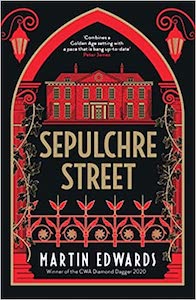 After thirty years as a crime writer’s wife, discussions about murder no longer surprise me. “If you wanted to kill me, how would you go about it?” is a problem on which I have advised Martin more than once.
After thirty years as a crime writer’s wife, discussions about murder no longer surprise me. “If you wanted to kill me, how would you go about it?” is a problem on which I have advised Martin more than once.
A writer is never off duty. I have learned that inspiration will strike in the most unlikely of locations, and that, while I am admiring a beautiful view, my husband will be considering where would be the best place to conceal a body. When I read the final drafts of his novels, I often recognise places we have visited and conversations we have had, transformed by his imagination into fiction.
One of my most enjoyable tasks recently has been drawing maps for his books, especially the series featuring Rachel Savernake which is set in the 1930s. The latest is Sepulchre Street. Maps and floor plans often featured in “Golden Age” detective novels, the kind of mysteries popular in the early twentieth century, in which readers were encouraged to try and solve the puzzle themselves before the fictional detective did.
The maps in Martin’s books begin with his scribbles on the back of an envelope, of which I must then produce a number of versions until he is completely satisfied.
I draw each version by hand with a fine liner pen rather than using a computer. I have been in the habit of carrying a sketchbook and pen with me for many years, and to me this is the medium which feels most natural. Once I have the overall layout right, I can embellish the map with drawings of trees and buildings.
To explain the hand drawn nature of the map, Martin usually attributes it to one of the characters in his book. Most of the places are at least partly inspired by real locations that we have both visited. Most recently, in Sepulchre Street, he used the town of Rye as a setting, and I kept closely to a map of the actual town from the period in the early 1930s when the story takes place, and studied photographs of the landmarks to ensure a degree of accuracy. In other books I am constrained only by the text, and I hope that my interpretations will be helpful to the reader, and not interfere with their own interpretation. The maps often foreshadow events, and for Mortmain Hall I particularly enjoyed portraying the steep cliffs on which a large house had been built perilously close to the edge. For The Crooked Shore I was also delighted to find that the official symbol for quicksand was the top half of a sinking man, arms raised in panic – I couldn’t have designed a better symbol myself.
It is hugely satisfying to see the maps as part of the complete book, and even on rare occasions to have them catch the eye of a reviewer. I enjoy drawing them, and hope that they give pleasure to readers too.

Head of Zeus -- an Aries Book
(11 May 2023)
HBK £20.00 Ebook Kindle £5.99
PHOTO MARTIN EDWARDS © MIKE STOTTER